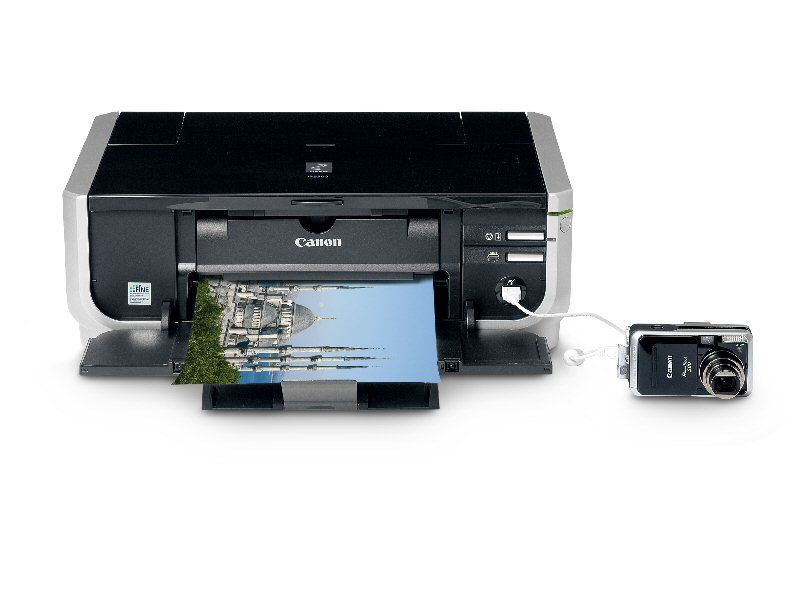The Canon PIXMA iP5300 is one of the third generation of PIXMA models that are pushing competitors such as HP, Lexmark and Epson to the limit in terms of their speed, print quality and versatility out of the box.
Our quick take
Apart from the slightly frustrating niggles with the set up process, it is fair to say this printer produces professional quality A4 prints at a very reasonable price, output is fast and, thanks to the ChromaLife100 inks, prints will last up to 100-years as well. Superb.

Canon PIXMA iP5300 printer - 4.5 / 5
| FOR | AGAINST |
|---|---|
|
|
The 5300 is a marked technological improvement over its forbear, the 5200 featuring five, two and one-picolitre ink nozzles and droplets from its FINE print head and a double encoder system to help achieve finely graded and very accurate high print speeds.
However, Epson printers have been using variable droplet size technology for some time with its piezo ejection print head system, which provides meniscus control of each droplet for fine print control
But this combination of such small sized nozzles on a thermal inkjet provide a great level of control of areas in prints such as fine cloud detail, skies and the like. In terms of speed the 5300 can shove out a borderless 6 x 4-inch print every 21-seconds, which is remarkably fast.
The five inks slot home into the device once you’ve stripped it of all the packaging and turned it on. You get cyan, magenta, yellow and black inks the latter doubled up in two ink tanks, one much higher capacity than the other. One is part of the ContrastPLUS technology designed to help give extra depth to the prints.
An A4 print takes around one minute and fifteen seconds at the same settings as above, but fine banding is visible across skin tones or areas of neutral colour of featureless detail. Up the print quality (incidentally, I was using the top Photo Paper Pro for this test) to the Super Fine setting print quality is remarkable. A downside though, is print speeds more than double their duration but having said that, the 5300 is still faster than most other printers of similar ilk.
In terms of its versatility, the 5300 may lack memory card slots but does sport a dedicated USB port for USB DirectPrint, PictBridge, or DPOF compatible digital cameras. However, it does have a neat DVD/CD print caddy that while slightly fiddly to use works well enough. Dual paper trays include a 150-sheet sheet feeder in the traditional place, on top of the printer.
The other is a cassette feeder that also holds up to 150-sheets of paper. You choose them feeder you want on buttons on the front of the printer or via the printer driver. A built-in duplex unit is hidden beneath a click-shut cover on the back and adds another level of versatility and an extra you’d have to attach as an accessory to the back and pay extra for.
My one gripe is the lengthy installation process, the software loads up only very slowly and once there, the auto head alignment did not activate properly either. Not a problem for me but potentially confusing for those coming to such a printer for the first time.
Another problem is the same head alignment system takes five sheets of A4 (the special pack of paper supplied for job had only four sheets in it!) and another 15-minutes to accomplish. At it was not quite right after one alignment iteration, so I had to do it twice over killing half an hour.
However, these are (relatively) minor gripes given the other excellent elements of this printer and as the print head is (semi) permanent (it can be changed if needed, but it is not supposed to need it) it will only ever need doing infrequently.
Replacing the 5300’s inks costs £9.99 for each of the magenta, yellow, cyan, and “normal” blacks; the larger, ContastPLUS black cartridge is £11.99. Alternatively, an ink kit with all inks costs £39.99. Prices are average for (original Canon) single inks while the page yield is very good indeed. The (typically) most used ink tank is the magenta, which is able to print around 290, 6 x 4-inch photos.
However, yields vary depending on the content of each image; Canon’s yield figures for the other inks (again all based on 6 x 4-inch photos) are, 4340 for the larger ContrastPLUS black tank, 1600 for the smaller black, 436 for the cyan, and 331 for the yellow ink tank.
Overall, the print quality is superb particularly at the super fine setting where all of that 9600 x 2400dpi resolution and tiny ink droplet technology is put to good use. ContrastPLUS works well enough, none of my prints lacked punch and in terms of colour, using Adobe RGB source image files but output using Canon’s own printer profiles for the 5300 colour is very accurate.
To recap
Fast print speeds coupled with versatility make this new PIXMA printer one to look out for
